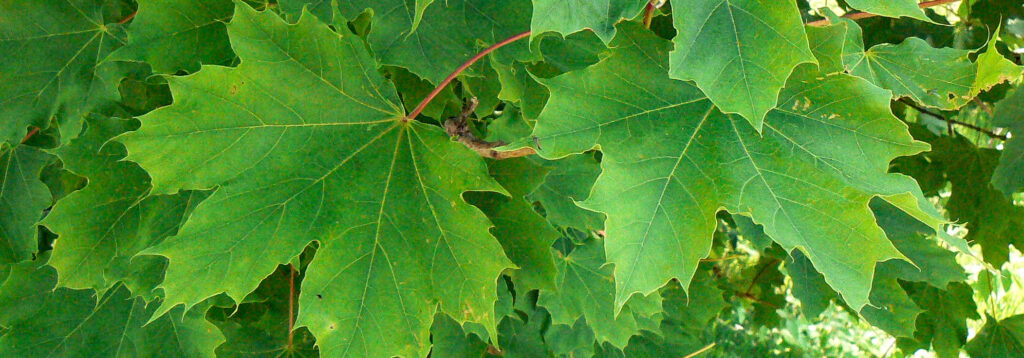Norway Maple
What is Norway Maple?
Native to Europe, Norway Maple (Acer platanoides) was introduced North America because of its aesthetically pleasing landscaping look. Nowadays varieties of the Norway maple are typically planted in urban areas because of their perceived aesthetics, tolerance to stress and rapid growth.
Description of Norway Maple
- The leaf buds are rounded.
- Leaves are oppositely arranged and have 5-7 lobes.
- Norway maple leaves tend to be wider than long.
- In late April, yellowish green flowers are produced in clusters.
- The stems and branches release a white sap when broken.
- Mature bark have a small crisscrossing groove pattern.
Description of Sugar Maple (similar looking native species)
- The leaf buds are pointed
- Leaves are oppositely arranged and have 5 lobes.
- Sugar maple leaves tend to be longer than wide.
- The tips of the points on the leaves are more rounded.
- The stems and branches release a clear sap when broken.
- Mature bark appear ‘shaggy’.

Where is Norway Maple found in our watershed?
Norway maple is a common urban tree in our watershed. Although significant encroachment into natural areas have not been observed to date, there is a high potential that this will occur.
Why is it of concern?
Norway maples grows rapidly and once established they create a thick canopy which block sunlight from the forest floor restricting growth of native shrubs and ground cover. Also, seedlings can create a thick mat in the shady forest understory and still establish since they are shade-tolerant. The roots of the Norway maple tend to grow close to the ground surface taking away moisture for native plant species.
How to control the spread
- The best method of controlling Norway maple is preventing the spread of more.
- Remember to refrain from planting any of the Norway maples on your property, which include the Crimson King, Emerald Queen, Drummondii, Dissectum, Columnare, and other varieties.
- Once established, removal of the Norway maple is difficult. Cutting down the tree to the base of the trunk and spraying the trunk with a herbicide is required.
- Good alternatives to Norway Maple include:
- Hackberry (adapted to a range of soil types and tolerates difficult urban conditions)
- Sugar maple (needs deep, rich soil)
- Silver and Freeman maples (needs moist soils)
- Downy and smooth serviceberry (tolerates wide range of soils and produces edible berries during the summer!)
- Speak to your tree nursery for more suggestions
What you can do
- Report sightings using EDDmapS.
- Use native or non-invasive tree species when landscaping on your property.
More information
- Quick Reference Guide to Invasive Plant Species (Norway Maple pg 10)
- Grow Me Instead
- The Landowner’s Guide to Controlling Invasive Woodland Plants
Invasive species on private property
NVCA does not offer a service to remove invasive species on private property. If you are looking for tips on dealing with invasive species on your property, see the links above, or visit Ontario’s Invading Species Awareness Program.